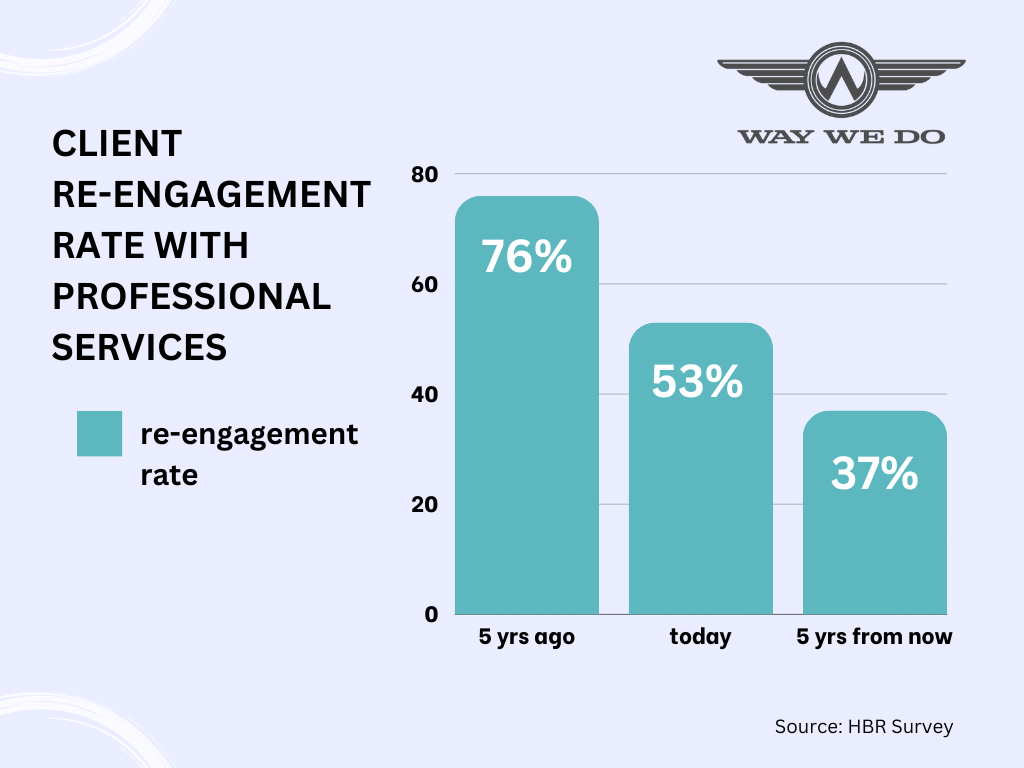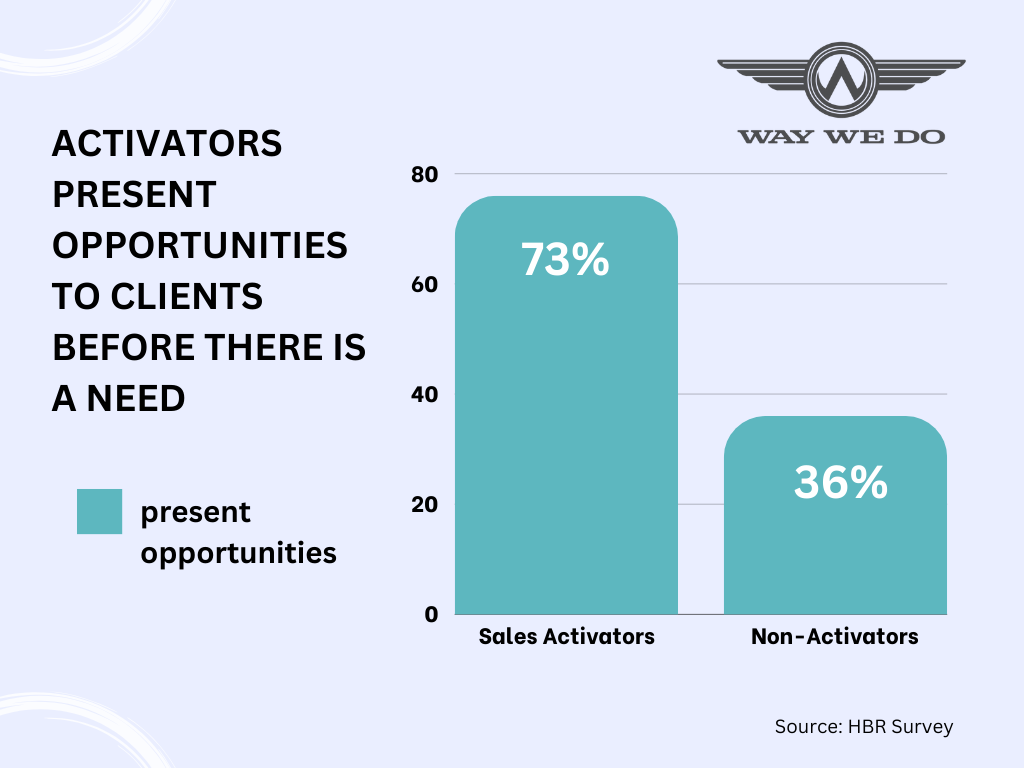In many industries, processes such as lead generation, sales, product delivery, customer success, and account management are distinct functions. However, in professional service firms, partners and consultants often wear multiple hats as “doer-sellers,” overseeing both business development and the delivery of services.
Consultants in professional services actively promote their expertise and services, secure new projects, carry out the work, and strive to foster long-term client relationships. This model is typical among management consultants, lawyers, accountants, public relations specialists, and executive search professionals to name a few.
Historically, once a consultant engaged with a client, there was a strong likelihood of repeat business. Nowadays, client loyalty is waning, with many seeking new consultants for the same services with the aim of cutting costs.
A Harvard Business Review (HBR) survey highlighted this shift. Five years ago, 76% of 100 C-level executives indicated they were likely to reengage with their previous consultants. That figure has since fallen to 53%, with projections suggesting a further decline to 37% over the next five years.

Business development practices — under the hood
Amid client demands for lower costs from service providers, the performance gap is becoming more pronounced. To examine this, HBR and Intapp conducted a comprehensive study involving nearly 1,800 partners from 23 firms, aiming to dissect their business development tactics and the effect on their success. This research scrutinized various factors including business development strategies, behavior patterns, time management, and resource utilization. Additionally, firm managers and leaders were asked to assess the performance of their partners.
The study also included detailed interviews with 80 high-achieving partners and 40 C-level executives from the participating firms.
The findings revealed five distinct profiles of business development approaches employed by partners at professional service firms, offering insights into the diverse strategies of engaging in business growth activities.
The study identifies five distinct business development profiles among partners at professional service firms:
| Profile | Behaviors |
|---|---|
| Experts | Respond to the existing demand in the market rather than creating new demand. Possess deep knowledge in specific areas that meet client needs. Prioritize working with clients who have predefined budgets. |
| Confidants | Are extremely attentive to the requirements of clients Provide outstanding value Establish profound connections with clients Use an impressive history of client projects to secure new opportunities Focus on relationships with top-level clients |
| Debaters | Hold strong views and is opinionated Debate clients on what they think is best for their business Deliver innovative solutions Have high expectation the client will agree with their plan |
| Realists | Focus on setting clear expectations with clients. Discuss budgets, fees, and timelines openly. Refuse client requests if necessary to avoid non-beneficial outcomes. |
| Activators | Engage in networking through events and social media to build a robust client base. Keep clients informed about significant trends and updates. Proactively propose new collaborative opportunities to clients. Link clients with additional partners and expertise, enhancing referral opportunities. |
And the winner is…
The study revealed that, regrettably, four of the five profiles were associated with subpar performance. Only the Activator profile exhibited a positive influence on both performance and revenue generation.
Compared to the other profiles, sales Activators achieved up to a 32% increase in revenue. On the other end of the spectrum, the Expert profile experienced a decline in revenue generation by as much as -15%.
What do Sales Activators do, that others don’t?
Commit
Activators dedicate a significant portion of their day—up to half—to business development efforts, including identifying and engaging potential clients on platforms like LinkedIn and participating in both industry-related and firm-sponsored events to nurture relationships with both new and existing clients.
Crucially, sales Activators allocate specific times in their agenda for these activities, balancing their focus evenly between nurturing existing relationships and cultivating new ones.
In contrast, non-Activators tend to rely on work from existing clients, hence spending most of their time with them rather than expanding their network with potential new clients.
A notable practice among committed partners involved organizing their weekly schedule at the beginning of the week into three main categories: client interactions, deal-specific tasks, and strategies for engaging both prospects and current clients. This structured approach helps in prioritizing contacts and objectives. They also make it a habit to record details of these engagements, outcomes, and conversations in a CRM system daily.
Business development activities online also encompass creating and sharing thought leadership content, engaging with content on LinkedIn by commenting and liking posts, and monitoring sales signals such as job changes or significant personal milestones. Additionally, they keep clients engaged by sharing relevant industry news.
Partners who consistently engage in daily business development activities report the generation of one new business opportunity every two to three days.
Connect
Activators cultivate strong networks that include both current and prospective clients, subject matter experts, and other valuable contacts.
Through these networks, Activators not only identify new business opportunities for themselves by converting contacts into clients but also frequently offer high-quality referrals to their colleagues. This involves linking clients and potential clients with other partners and departments within their firm, fostering a collaborative environment.
For service professionals in smaller firms, this strategy extends to cross-referrals with trusted, like-minded professionals in other firms, broadening the scope of potential opportunities and collaborative efforts. Such cross-referrals can significantly enhance the value provided to clients, opening doors to a wider range of expertise and services.
Moreover, sales Activators make a point of establishing connections with various stakeholders across their client’s organization, including those who can impact decisions, not limiting their efforts to just the top decision-makers. This approach allows them to extend their influence throughout the entire organization.
Create
Activators gather insights on key developments relevant to their current and potential clients, including regulatory changes, economic shifts, news events, and judicial decisions. They proactively initiate discussions with clients to explore any forthcoming opportunities, challenges or issues these changes might precipitate.
Even when a topic falls beyond their primary area of expertise, Activators do not hesitate to involve. Should they encounter a need they can’t meet directly, they facilitate connections with relevant experts within their network.
Looking forward, Activators understand the long-term value of these interactions. They recognize that while immediate business may not always result from these engagements, they are laying the groundwork for future opportunities through the credibility and rapport they build.
A significant 73% of sales Activators are known to present clients with opportunities before the clients recognize a need themselves, a proactive approach seen only in 36% of non-Activators.

Develop your Sales Activators team
For many partners in Professional Service firms, business development does not come instinctively. Moreover, as part business owners, partners often prefer engaging in activities they enjoy rather than strictly adhering to an organizational sales playbook.
To steer partners towards more proactive “Activator” behaviors, firms are advised to adopt a “push-pull” strategy, involving:
- Training and Coaching: Use Way We Do to craft and impart training on effective business development strategies and best practices.
- Hiring and Partner Selection: Prioritizing collaboration skills in addition to technical prowess during the hiring process.
- Technology: Leveraging CRM systems, AI, and social media platforms such as LinkedIn, along with collaboration and communication tools like Slack and Microsoft Teams.
- Incentives and Rewards: Recognizing and logging business development efforts within the firm to encourage participation.
Quick professional services case studies…
McDermott Will & Emery, noted as the fastest-growing law firm in the United States, expanded its revenue from $800 million to $1.8 billion through a global training program that equips partners with skills to effectively manage their networks.
Similarly, Eversheds Sutherland emphasizes business development training from the associate level—well before partnership consideration—as well as for current fee earners, underlining the importance of early and ongoing development in these skills.





